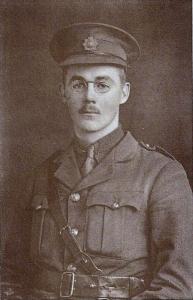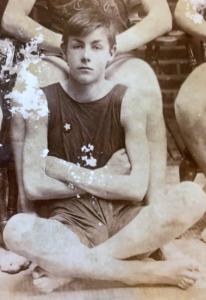
|

|
| Lieutenant John Howard TANNER | |
|
10th (Service) Battalion Hampshire Regiment Date of birth: 15th November 1892 Date of death: 15th September 1916 Killed in action aged 23 Buried at Struma Military Cemetery Plot II Row E Grave 7 |

|
| John Howard Tanner was born at Upper Norwood on the 29th of November 1892 the second son of Walter John Tanner, a solicitor, and Florence Evangeline (nee Tower) Tanner later of St Mary’s House, 24 Dyke Road, Brighton in Sussex. He was christened at Christ Church, Gypsy Hill, Norwood in Surrey on the 29th of December 1892. He was educated at St Ronan's School, Worthing and at Lancing College where he was in Olds House from September 1905 to April 1911. He was a member of the Football XI in 1910/11 and in the Swimming VI in 1909. In October 1911 he went on to Keble College Oxford where he was a member of the College Football XI from 1912 to 1914. He was a member of the Oxford University Officer Training Corps and graduated with a 3rd Theology and a BA in 1914. Following the outbreak of war he applied for a commission in the infantry on the 17th of August 1914. At a medical examination, which took place at Oxford on the same day, it was recorded that he was five feet eleven inches tall and that he weighed 155lbs. He was commissioned as a 2nd Lieutenant in the Hampshire Regiment on the 28th of January 1915 and was promoted to Lieutenant on the 28th of January 1915. On the 6th of July 1915 he sailed with his battalion from Liverpool on board the SS "Transylvania", arriving in Alexandria in Egypt on the 17th of July before continuing on to Mudros where they arrived on the 26th. On the afternoon of the 5th of August the battalion, less 150 men who were left behind in reserve at Lemnos, were ferried in small vessels to the beaches at Gallipoli. They were in full kit and carried three days rations per man. They landed at daybreak on the 6th and hurried into Shrapnel Gully in order to protect them from Turkish observation. They spent a frustrating couple of days before moving into position in the early hours of the 9th of August in support of an attack at Chunuk Bar. They split into two groups, one group incurring a few casualties during the day as they filled a gap in the line near a position known as "The Farm". The other group also suffered casualties at Rhododendron Spur. On the morning of the 10th the Turks counterattacked in great force in order to recover their losses of the previous day. Despite ferocious fighting the allied troops were pushed out of "The Farm" and the Hampshires fell back to Cheshire Ridge where they managed to hold the line against repeated onslaughts. John Tanner was severely wounded by shrapnel in the foot and the hand during the fighting and was evacuated from the peninsular on board the Hospital Ship "Neuralia", arriving at Alexandria on the 16th of August 1915 where he was admitted to 15 General Hospital. A Medical Board sat there on the 24th of August to consider his injuries:- "He is suffering from a gunshot wound of the left foot received in action on the 10th August. A shrapnel bullet entered the outer side of the sole of the left foot, and was found in his boot. Secondary hemorrhage occurred and the anterior tibia artery was ligatured. The Board consider that this officer will not be fit for service for three months and recommends that he be sent to England." He was evacuated to England on board the Hospital Ship "Glengorm Castle" on the 8th of September and landed at Southampton on the 9th of September 1915. He was admitted to the Royal Victoria Hospital at Netley where a Medical Board was convened to report on his case on the 14th of October 1915: - "The Board find that this officer was wounded in action on the 10/8/15 and that he received: - 1) Shrapnel wound of the left foot which necessitated ligature of the anterior tibial artery owing to secondary hemorrhage. X-rays shows damage to the 5 metatarsal bone, also slight damage to the 4th metatarsal and cuboid bones, the wound has almost healed. 2) Shrapnel wound of the left side superficial and through the abdominal muscles. 3) Shrapnel wound of he left middle finger and grazing in character. X-rays shows no apparent damage to the phalanx. A Medical Board which sat at Shoreham on the 7th of March 1916 concluded that his wounds were healed and that he was fit for light duties. They posted to the 13th (Reserve) Battalion of his regiment based at Bovington Camp and he joined them there the following day. A Medical Board which sat at Brigade Headquarters, Wareham on the 8th of May 1916 concluded that he was fit for general service. On the 31st of May 1916 he embarked on board SS "Kalyan" at Devonport and landed at Sidi Bashir in Egypt on the 11th of June. He re-embarked at Alexandria on the 14th of June and rejoined his battalion in the field in Salonica on the 30th of June 1916. By August 1916 the battalion had suffered such losses from malaria that on the 21st of August it was merged with the remnants of three other battalions to form the 29th Composite Battalion under the command of Lieutenant Colonel Beckett of the Hampshires. The 10th Hampshires provided one company of this new formation. On the 27th of August the new battalion took over positions on the Struma River between Komarjan Bridge and Zouave Wood. During this period the battalion was involved in a series of raids and local attacks against the Bulgarian troops opposite. On the 15th of September 1916 they planned an attack against the villages of Komarjan and Jeni Mahale. Half the attacking force under Major Garsia, and including John Tanner, crossed the river in rafts to Chasseur Island and made for Jeni Mahale. They were supported by artillery and worked steadily forward despite heavy enemy counter fire. When they were 100 yards from the village they rushed it and quickly overcame the defenders. During this phase of the attack John Tanner was shot and killed. The survivors readied themselves for a counterattack but this was not forthcoming and they withdrew after an hour. The rest of the battalion attacked at Komarjan and fell back at 7pm as arranged. Casualties were Lieutenant John Tanner and five other ranks killed with fourteen other ranks wounded. His father received the following telegram dated the 16th of September 1916: - "Deeply regret to inform you Lieut. J.H. Tanner Hampshire Regt. was killed in action September 15th. The Army Council express their sympathy." A fellow officer wrote:- "His platoon was detailed to make the attack on the left of the village, and was within 100 yards of the objective. He had his men well in hand, and had just gone up to make the final rush, when he was shot through the head and killed immediately. Previous to the attack he had done excellent reconnaissance work, and his men would have followed him anywhere. He was also a favorite among the officers." His mother applied for his medals in February 1922. He is commemorated on the war memorial at St Ronan's School and on the memorial at Keble College Oxford. |
|
 | |
| Olds House |
Back